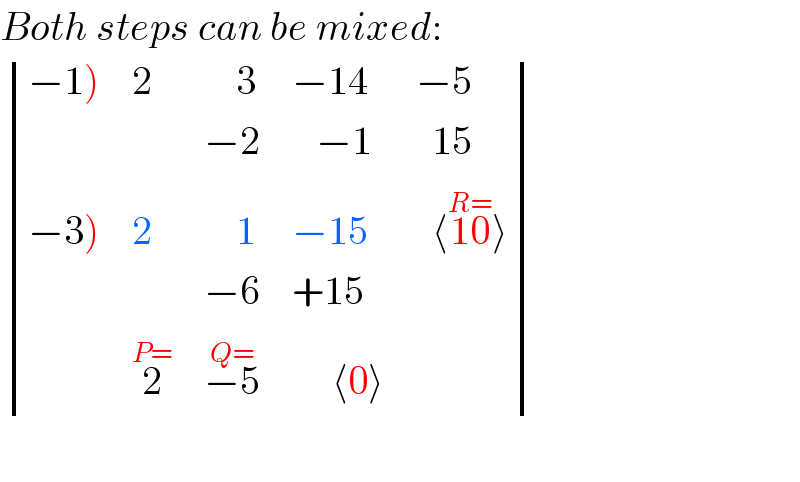Question Number 108888 by bemath last updated on 20/Aug/20

$$\:\:\:\frac{\vdots\mathcal{B}{e}\mathcal{M}{ath}\vdots}{\bigtriangleup} \\ $$$${Suppose}\:\mathrm{2}{x}^{\mathrm{3}} +\mathrm{3}{x}^{\mathrm{2}} −\mathrm{14}{x}−\mathrm{5}=\:\left({Px}+{Q}\right)\left({x}+\mathrm{3}\right)\left({x}+\mathrm{1}\right)+{R}\:{for}\:{all} \\ $$$${value}\:{of}\:{x}.\:{Find}\:{the}\:{value}\:{of}\:{P},{Q}\:{and}\:{R}\: \\ $$
Answered by Rasheed.Sindhi last updated on 20/Aug/20

$$\:\underset{\bullet} {\overset{\bullet} {\rangle}}\underset{\bullet} {\overset{\bullet} {\mid}}\underset{\bullet} {\overset{\bullet} {\langle}}\:\mathrm{Comparing}\:\mathrm{Coefficients}\:\: \\ $$$$\mathrm{2}{x}^{\mathrm{3}} +\mathrm{3}{x}^{\mathrm{2}} −\mathrm{14}{x}−\mathrm{5} \\ $$$$\:\:\:\:\:\:\:\:=\:\left({Px}+{Q}\right)\left({x}+\mathrm{3}\right)\left({x}+\mathrm{1}\right)+{R}\: \\ $$$$\:\:\:\:\:\:\:\:={Px}^{\mathrm{3}} +\left(\mathrm{4}{P}+{Q}\right){x}^{\mathrm{2}} +\left(\mathrm{3}{P}+\mathrm{4}{Q}\right){x}+\mathrm{3}{Q}+{R} \\ $$$${Comparing}\:{coefficients}: \\ $$$${P}=\mathrm{2},\:\mathrm{4}{P}+\mathrm{Q}=\mathrm{3},\mathrm{3}{P}+\mathrm{4}{Q}=−\mathrm{14} \\ $$$$\mathrm{3}{Q}+{R}=−\mathrm{5} \\ $$$${Q}=\mathrm{3}−\mathrm{4}{P}=\mathrm{3}−\mathrm{4}\left(\mathrm{2}\right)=−\mathrm{5} \\ $$$${Q}=−\mathrm{5},{R}=−\mathrm{5}−\mathrm{3}{Q}=−\mathrm{5}−\mathrm{3}\left(−\mathrm{5}\right) \\ $$$${R}=\mathrm{10}\:\:\:\:\:\:\:\:\:\:\:\:\:\:\:\:\:\:\:\:\:\:\:\:\:_{\lll\bullet\:} ^{\ggg\:\bullet} {Rasheed}_{\:\bullet\lll} ^{\:\:\bullet\ggg} \\ $$
Commented by bemath last updated on 20/Aug/20

$${cooll}\:…{nice} \\ $$
Answered by bobhans last updated on 20/Aug/20

$${put}\:{x}\:=\:−\mathrm{1}\:\rightarrow{R}=−\mathrm{2}+\mathrm{3}+\mathrm{14}−\mathrm{5}=\mathrm{10} \\ $$$${then}\:\mathrm{2}{x}^{\mathrm{3}} +\mathrm{3}{x}^{\mathrm{2}} −\mathrm{14}{x}−\mathrm{5}=\left({Px}+{Q}\right)\left({x}+\mathrm{3}\right)\left({x}+\mathrm{1}\right)+\mathrm{10} \\ $$$$\left({Px}+{Q}\right)\left({x}+\mathrm{3}\right)\left({x}+\mathrm{1}\right)=\mathrm{2}{x}^{\mathrm{3}} +\mathrm{3}{x}^{\mathrm{2}} −\mathrm{14}{x}−\mathrm{15} \\ $$$${divided}\:{by}\:{x}+\mathrm{1}\:{in}\:{RHS}\:{we}\:{got}\:{factorise} \\ $$$$\left({x}+\mathrm{1}\right)\left(\mathrm{2}{x}^{\mathrm{2}} +{x}−\mathrm{15}\right)=\left({x}+\mathrm{1}\right)\left(\mathrm{2}{x}\:−\mathrm{5}\right)\left({x}+\mathrm{3}\right) \\ $$$${so}\:{we}\:{obtain}\:\rightarrow\begin{cases}{{P}\:=\:\mathrm{2}}\\{{Q}=−\mathrm{5}}\end{cases} \\ $$
Commented by bemath last updated on 20/Aug/20

$${cooll}…\bigstar \\ $$
Answered by Rasheed.Sindhi last updated on 20/Aug/20

$$\:\:\:\:\:\underset{\subset} {\overset{\cap} {\mathrm{S}}yntheic}\:\mathrm{Division}\:\mathrm{metho}\underset{\cup} {\overset{\supset} {\mathrm{d}}} \\ $$$$\:{g}\left({x}\right):\mathrm{2}{x}^{\mathrm{3}} +\mathrm{3}{x}^{\mathrm{2}} −\mathrm{14}{x}−\mathrm{5} \\ $$$$\:\:\:\:\:\:=\:\left({Px}+{Q}\right)\left({x}+\mathrm{3}\right)\left({x}+\mathrm{1}\right)+{R} \\ $$$${g}\left({x}\right)\:{on}\:{dividing}\:{by}\:{x}+\mathrm{1}\:{gives}\: \\ $$$${remainder}\:{R}\:{and}\:{quotient}\:{q}\left({x}\right): \\ $$$$\begin{vmatrix}{\left.−\mathrm{1}\right)}&{\mathrm{2}}&{\:\:\:\:\mathrm{3}}&{−\mathrm{14}}&{−\mathrm{5}}\\{}&{}&{−\mathrm{2}}&{\:\:\:−\mathrm{1}}&{\:\:\mathrm{15}}\\{}&{\mathrm{2}}&{\:\:\:\:\mathrm{1}}&{−\mathrm{15}}&{\:\:\overset{{R}=} {\mathrm{10}}}\end{vmatrix} \\ $$$${q}\left({x}\right)=\mathrm{2}{x}^{\mathrm{2}} +{x}−\mathrm{15}\:,\:{R}=\mathrm{10} \\ $$$${q}\left({x}\right)\:{on}\:{dividing}\:{by}\:{x}+\mathrm{3}\:{gives} \\ $$$${remainder}\:\mathrm{0}\:{and}\:{quotient}\:{Px}+{Q} \\ $$$$\begin{vmatrix}{\left.−\mathrm{3}\right)}&{\mathrm{2}}&{\:\:\:\:\mathrm{1}}&{−\mathrm{15}}\\{}&{}&{−\mathrm{6}}&{+\mathrm{15}}\\{}&{\overset{{P}=} {\mathrm{2}}}&{\overset{{Q}=} {−\mathrm{5}}}&{\:\:\:\:\:\:\:\mathrm{0}}\end{vmatrix} \\ $$$${Px}+{Q}=\mathrm{2}{x}−\mathrm{5} \\ $$$${P}=\mathrm{2},\:{Q}=−\mathrm{5} \\ $$
Commented by Rasheed.Sindhi last updated on 20/Aug/20

$${Both}\:{steps}\:{can}\:{be}\:{mixed}: \\ $$$$\begin{vmatrix}{\left.−\mathrm{1}\right)}&{\mathrm{2}}&{\:\:\:\:\mathrm{3}}&{−\mathrm{14}}&{−\mathrm{5}}\\{}&{}&{−\mathrm{2}}&{\:\:\:−\mathrm{1}}&{\:\:\mathrm{15}}\\{\left.−\mathrm{3}\right)}&{\mathrm{2}}&{\:\:\:\:\mathrm{1}}&{−\mathrm{15}}&{\:\:\langle\overset{{R}=} {\mathrm{10}}\rangle}\\{}&{}&{−\mathrm{6}}&{+\mathrm{15}}&{}\\{}&{\overset{{P}=} {\mathrm{2}}}&{\overset{{Q}=} {−\mathrm{5}}}&{\:\:\:\:\:\langle\mathrm{0}\rangle}&{}\end{vmatrix} \\ $$$$ \\ $$
